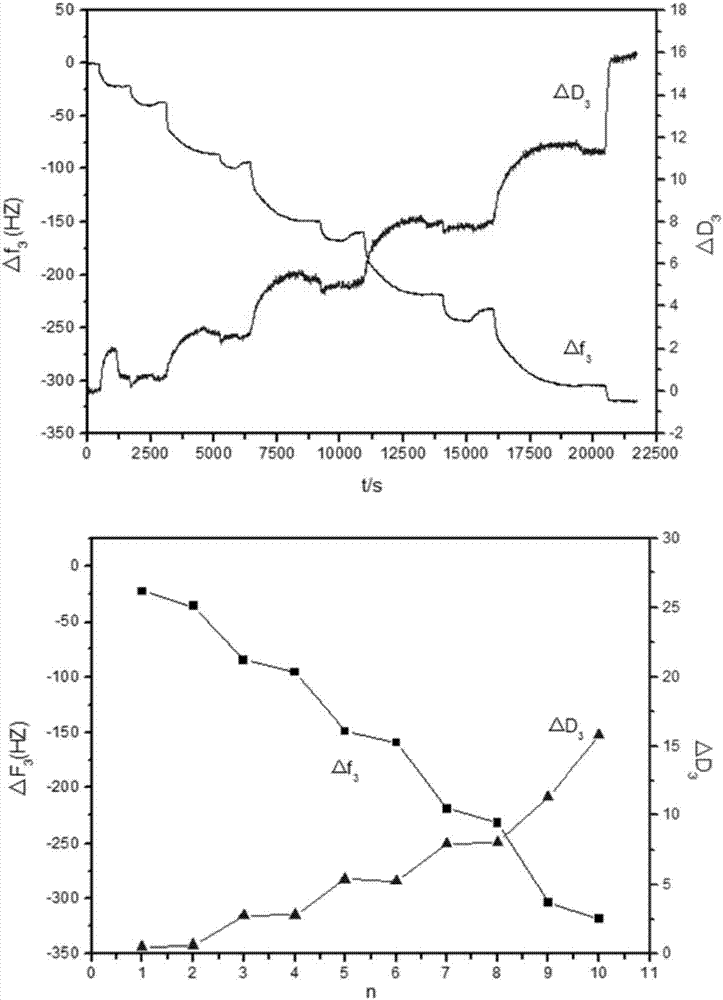Preparation method of self-assembled lysozyme multilayer membrane with antibacterial property and biocompatibility
A biocompatible, lysozyme technology, applied in coatings, pharmaceutical formulations, drug delivery, etc., to achieve the effect of simple and easy method, reduced damage, and broad application prospects
- Summary
- Abstract
- Description
- Claims
- Application Information
AI Technical Summary
Problems solved by technology
Method used
Image
Examples
Embodiment 1
[0031] This embodiment includes the following steps:
[0032] (1) Substrate pretreatment of self-assembled membrane
[0033] After surface treatment, the glass is immersed in a polyethyleneimine solution with a concentration of 0.01mg / mL to self-assemble to form the bottom layer;
[0034] (2) Preparation of plant polyphenol aqueous solution
[0035] Prepare 10ml of 10mM HEPES buffer solution, pH=4, add ascorbic acid to 5mM and tannic acid (TA) to 0.01mg / ml in turn, stir until completely dissolved, and prepare a tannic acid aqueous solution with a concentration of 0.01mg / mL;
[0036] (3) Preparation of protein aqueous solution
[0037] Configure 10ml of 10mM HEPES buffer solution, adjust the pH to 4, add 5mM to ascorbic acid and lysozyme to 0.01mg / ml in sequence, stir until completely dissolved, and prepare a lysozyme aqueous solution with a concentration of 0.01mg / mL;
[0038] (4) Preparation of self-assembled multilayer films
[0039] Immerse the substrate treated in step...
Embodiment 2
[0042] This embodiment includes the following steps:
[0043] (1) Substrate pretreatment of self-assembled membrane
[0044] After surface treatment, the glass is immersed in a polyethyleneimine solution with a concentration of 1 mg / mL to self-assemble to form the bottom layer;
[0045] (2) Preparation of plant polyphenol aqueous solution
[0046] Prepare 50mM HEPES buffer solution, pH=6, sequentially add sodium chloride to 0.15mol / l, ascorbic acid to 10mM and tannic acid (TA) to 1mg / mL, stir until completely dissolved, and prepare a single solution with a concentration of 1mg / mL. Nitric acid aqueous solution;
[0047] (3) Preparation of protein aqueous solution
[0048]Prepare 50mM HEPES buffer solution, pH=6, sequentially add sodium chloride to 0.15mol / l, ascorbic acid to 10mM and lysozyme to 1mg / mL, stir until completely dissolved, and prepare a lysozyme aqueous solution with a concentration of 1mg / mL;
[0049] (4) Preparation of self-assembled multilayer films
[0050...
Embodiment 3
[0052] This embodiment includes the following steps:
[0053] (1) Substrate pretreatment of self-assembled membrane
[0054] After surface treatment, the glass is immersed in a polyethyleneimine solution with a concentration of 10 mg / mL to self-assemble to form the bottom layer;
[0055] (2) Preparation of tannic acid aqueous solution
[0056] Prepare 50mM HEPES buffer solution, pH=8, sequentially add sodium chloride to 0.5mol / l, ascorbic acid to 50mM and tannic acid (TA) to 10mg / ml, stir until completely dissolved, and configure a single solution with a concentration of 10mg / mL Nitric acid aqueous solution;
[0057] (3) Preparation of lysozyme aqueous solution
[0058] Prepare 50mM HEPES buffer solution, pH=8, add sodium chloride to 0.5mol / l, ascorbic acid to 50mM and lysozyme to 10mg / ml in sequence, stir until completely dissolved, and prepare a lysozyme aqueous solution with a concentration of 10mg / mL;
[0059] (4) Preparation of self-assembled multilayer films
[0060...
PUM
| Property | Measurement | Unit |
|---|---|---|
| concentration | aaaaa | aaaaa |
Abstract
Description
Claims
Application Information
 Login to View More
Login to View More - R&D
- Intellectual Property
- Life Sciences
- Materials
- Tech Scout
- Unparalleled Data Quality
- Higher Quality Content
- 60% Fewer Hallucinations
Browse by: Latest US Patents, China's latest patents, Technical Efficacy Thesaurus, Application Domain, Technology Topic, Popular Technical Reports.
© 2025 PatSnap. All rights reserved.Legal|Privacy policy|Modern Slavery Act Transparency Statement|Sitemap|About US| Contact US: help@patsnap.com

